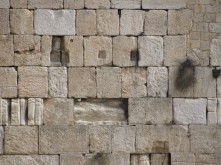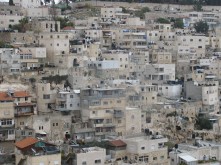She posted this yesterday, and I think it quite insightful and very much worth your consideration:
Walls, stones and what is sacred
January 22, 2012I’m a writer and I swim in words. But occasionally, there is an image that expresses things better than any words I could write.
When I was in Israel back in November, I took several photographs of the stones of the Western Wall because I loved all the textures and colors. It’s a classic image; I thought it might be useful sometime for this blog.
Then, as I wrote about in an earlier post, we walked a few hundred steps outside the Old City to the disputed Arab neighborhood of Silwan. And this is what I saw:
When I squinted my eyes, those images blurred and became the same — both patchworks of textured white stone.
One was the Wall, the most sacred site in Judaism. The other was a workaday Palestinian neighborhood.
The Torah portion for my Bat Mitzvah service almost a year ago concerned construction of the Tabernacle, and I talked about how places — official “sacred” places, places in wild nature, other kinds of places and settings — can help us get in touch with the spiritual part of ourselves.
But physical places can also become idols, false gods.
I understand how, for many people, the Western Wall is a sacred place. But what those photos say to me is that living communities — the people in them, no matter the nationality or religion — are equally sacred.
To me, the people of Israel and Palestine will always be worth more than any particular place. No stone wall is worth a human life, no matter how many thousands of years of Jewish history it embodies. No olive tree is worth a human life, no matter how many generations of Palestinian family tradition it represents.
That’s the basis of the land-for-peace concept, the basis of a two-state solution. Both Israelis and Palestinians must give up some places that are precious to them in order to save lives that are ultimately more precious.
With right-wingers like Netanyahu and Lieberman running the Israeli government, and the rejectionists of Hamas tying the hands of Palestinian moderates, that solution seems almost impossibly distant these days.
But governments can change — maybe Israel’s will. And perhaps a more open Israeli government will spark a parallel openness among Palestinians. What we can do, in the meantime, is keep reminding ourselves and our leaders that human lives are more sacred than any walls, trees or stones. That’s why I support groups like J Street and Americans for Peace Now.
There! It just took me 379 words to deliver this preachy message.
When really, all it takes is looking at those two images.
When I was in Israel back in November, I took several photographs of the stones of the Western Wall because I loved all the textures and colors. It’s a classic image; I thought it might be useful sometime for this blog.
Then, as I wrote about in an earlier post, we walked a few hundred steps outside the Old City to the disputed Arab neighborhood of Silwan. And this is what I saw:
When I squinted my eyes, those images blurred and became the same — both patchworks of textured white stone.
One was the Wall, the most sacred site in Judaism. The other was a workaday Palestinian neighborhood.
The Torah portion for my Bat Mitzvah service almost a year ago concerned construction of the Tabernacle, and I talked about how places — official “sacred” places, places in wild nature, other kinds of places and settings — can help us get in touch with the spiritual part of ourselves.
But physical places can also become idols, false gods.
I understand how, for many people, the Western Wall is a sacred place. But what those photos say to me is that living communities — the people in them, no matter the nationality or religion — are equally sacred.
To me, the people of Israel and Palestine will always be worth more than any particular place. No stone wall is worth a human life, no matter how many thousands of years of Jewish history it embodies. No olive tree is worth a human life, no matter how many generations of Palestinian family tradition it represents.
That’s the basis of the land-for-peace concept, the basis of a two-state solution. Both Israelis and Palestinians must give up some places that are precious to them in order to save lives that are ultimately more precious.
With right-wingers like Netanyahu and Lieberman running the Israeli government, and the rejectionists of Hamas tying the hands of Palestinian moderates, that solution seems almost impossibly distant these days.
But governments can change — maybe Israel’s will. And perhaps a more open Israeli government will spark a parallel openness among Palestinians. What we can do, in the meantime, is keep reminding ourselves and our leaders that human lives are more sacred than any walls, trees or stones. That’s why I support groups like J Street and Americans for Peace Now.
There! It just took me 379 words to deliver this preachy message.
When really, all it takes is looking at those two images.


No comments:
Post a Comment